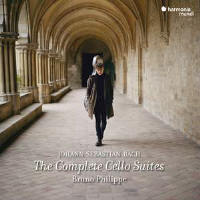Texte paru dans: / Appeared in: |
|
|
Outil de traduction |
|
|
‘I am convinced that honesty and faith in one’s ideas can result in a form of individuality’, claims the French cellist Bruno Philippe, who humbly acknowledges the existence of many exceptional recordings of these interpretatively inexhaustible masterpieces. Philippe studied as a young soloist at the Kronberg Academy with Frans Helmerson and participated in masterclasses given by David Geringas, Steven Isserlis, Gary Hoffman, Pieter Wispelwey and Clemens Hagen at the Salzburg Mozarteum.
During the course of yet another productive lockdown project, Philippe found himself playing solo Bach using gut strings and a Baroque bow, and revising his attitudes to tempo, strong and weak beats in the dance movements, the density of chords and so forth. The sum effect of these and other alterations in his approach has led to a set of the Suites that is as lively and gutsy as it is thoughtful, six varied dance sequences that compare in qualitative terms with Bach’s greatest solo instrumental works, whether for violin or keyboard.
Take the freedom of the First Suite’s Prelude and Allemande, incorporating tiny bends in the line. Or the Courante, with its embellished repeats and added trills. Minuets Nos 1 and 2 are vividly contrasted, No 2 (1'16") taken at twice the tempo of the first. Also pretty nifty is the closing Gigue, decorative and gaily dancing yet still maintaining Philippe’s characteristically mellow tone. Likewise No 2’s Courante, a hectic scamper, whereas the ensuing Sarabande suggests a funereal processional, as does the parallel movement in the Fourth Suite.
The popular Third Suite opens to a highly mobile toccata-like Prelude, the arpeggios bouncing along a vividly focused bass line, the Bourrées – played in tempo – trippingly done, though sounding Steven Isserlis captures more of the music’s innate sense of joy. The Gigue is reminiscent of Daniil Shafran in its lightness and rhythmic drive (compare Jean-Guihen Queyras’s more pointed emphases – Harmonia Mundi). No 4’s Bourrées are swift and buoyant, with varied articulation, whereas No 5’s growling Courante becomes a dyspeptic baroque elder. By contrast, the Sarabande that follows expresses unfathomable loneliness, eventually giving way to a pair of energetic, harmonically rich Gavottes and a taut closing Gigue that recalls the even more purposeful (and vibrant) Casals. In Philippe’s hands No 6’s Prelude is obsessively motoric, with no sign of strain in the instrument’s upper reaches, the Courante delightfully sparky, the second Gavotte like a hurdy-gurdy with enriched harmonies.
In closing, I’d place this new set alongside my favourites among its digital rivals: Emmanuelle Bertrand (Harmonia Mundi, A/19), Yo-Yo Ma (his sublime latest recording – Sony, A/18), Steven Isserlis (Hyperion, 7/07) and Alisa Weilerstein (Pentatone, 7/20). Philippe’s principal virtues are the way he allows the music to dance and his easy, unforced manner of projection. It’s a set that makes auditioning these Suites in a single fell swoop (which is what I did when initially listening) as undemanding as it is rewarding. |
|
_small.jpg)



